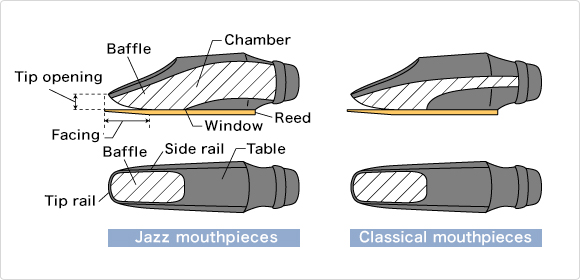Choosing a Saxophone
How to choose a reed and mouthpiece
Look for a mouthpiece that suits you
Mouthpieces are interchangeable, so most of them will fit any neck. Even if the mouthpiece is a little too loose or too tight, the cork can be easily shaved or replaced, so you can choose any mouthpiece you like.
We recommend that beginners start out with a standard mouthpiece (for Yamaha, this is the 4C) together with a 2 1/2 reed, and practice the basics of playing long tones, making sure to get their embouchure (the shape and action of the mouth and lips that controls the sound using the muscles around the mouth) correct, and from there go on to choose something that fits their taste.
The relationship between mouthpiece and reed selection
The most important factor in selecting a reed is the reed thickness.
Reed thickness is most often expressed as a number. The normal range for reeds is 2 to 5: the lower the number, the thinner the reed, and the higher the number, the thicker the reed. The thickness of the reed will affect the tone and how easy or difficult the instrument is to play. In general, a thinner reed, say 2 or 2.5, will have a brighter tone. Thinner reeds vibrate more easily, so they are good for beginners. Players of popular music or jazz often prefer this brighter tone and thus use thinner reeds. Reeds with a thickness of 4 or 5 are harder and thus require more skill to sound, but the tone is fatter, bigger, and warmer.
By the way, the reed is a consumable item and must be replaced often. This is sometimes a concern, so, recently, convenient resin reeds that are easy to maintain and last a long time have appeared.
An important point when choosing a reed is the compatibility with the mouthpiece.
The space between the tip of the mouthpiece and the tip of the attached reed is an important factor affecting the performance of a reed instrument. This space determines the "channel" that the player's breath follows. The opening at the mouthpiece is called the "tip opening." For example, what would result from a mouthpiece with a narrow tip opening and a thin reed? The vibration of a thin reed has higher amplitude, and so the vibrating reed will completely cover the mouthpiece, blocking the air channel and possibly suddenly interrupting the sound of the instrument. Important mouthpiece characteristics in addition to the tip opening are the table, where the reed attaches, and the facing, the angle of the curve near the tip of the mouthpiece. There are specific reeds designed to meet these requirements. It is necessary to choose a reed that fits the specific shape of the mouthpiece.

The names of mouthpiece parts
However, more advanced players can play the more difficult-to-play combinations, and so they can choose the combination of mouthpiece and reed to achieve a particular sound. For example, to achieve a deeper, dark tone, many players choose a mouthpiece with a large tip opening and a thick reed.
Thus, there are many different opinions about mouthpiece and reed combinations, and there is an infinite number of combinations. This may be why many beginners become confused on this point. If you are unsure about which reed and mouthpiece to select, consult the staff at your local music store.
